While searching Board Minute summaries for inspiration for this Christmas themed blog, I came across an entry dated 24 December 1857, which stated Serjeant Key was to be given £10 for a ‘Christmas dinner to Sappers’. According to The National Archives Currency Converter, £10 in 1860 would be worth the equivalent of £590 in 2017, a seemingly generous sum that presumably would have provided a decent dinner.

Further research revealed that by December 1861 it had become customary for each Royal Engineer to receive 5 shillings (equivalent to £14) as a Christmas bonus, instead of a communal Christmas dinner fund.
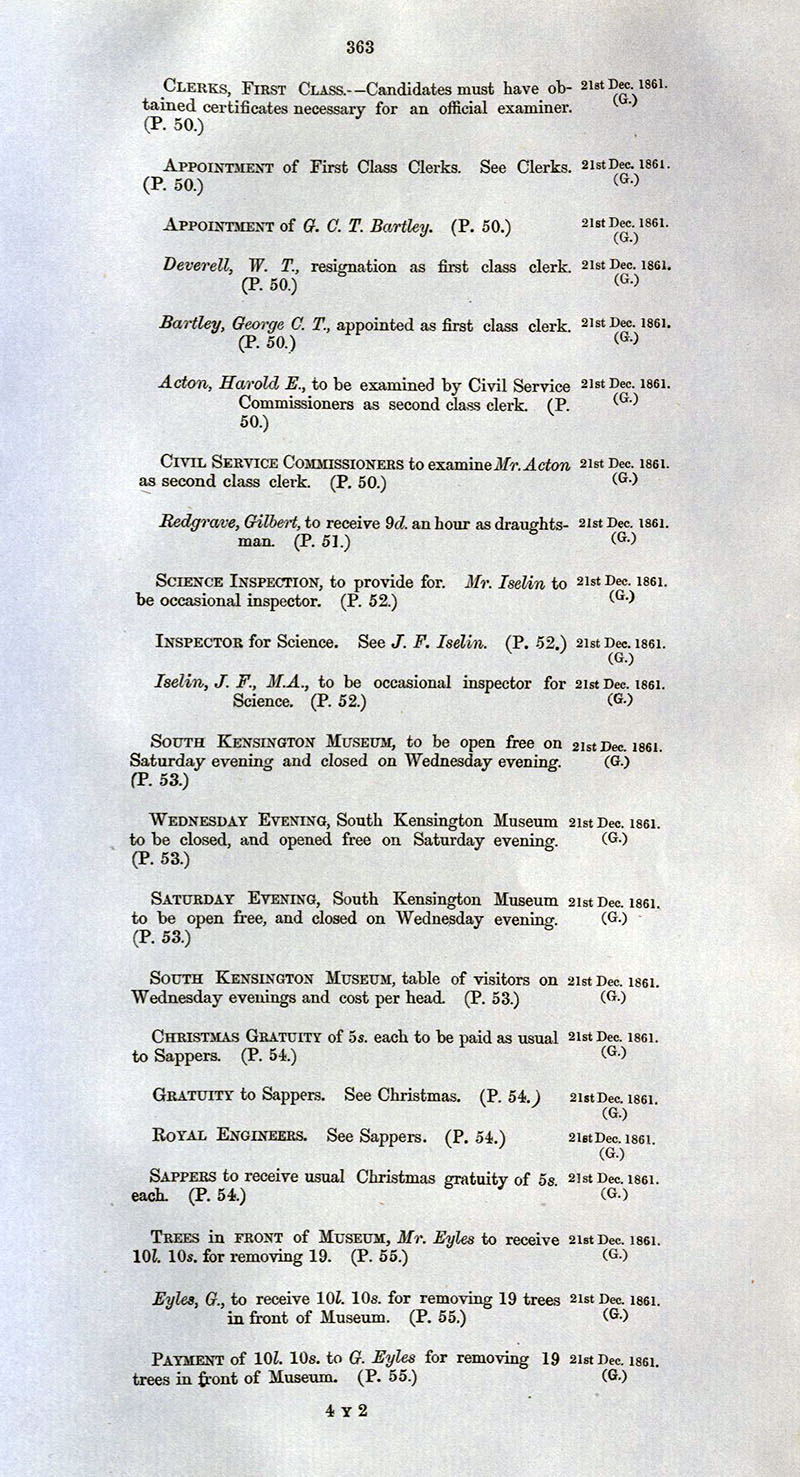
These short but intriguing statements raised several questions, the most obvious being, why the V&A was financing a Christmas allowance for soldiers. At first, I concluded the payment was a charitable donation, but further research in the V&A’s archives revealed that the Royal Engineers were being employed by the South Kensington Museum (the precursor to the V&A). The payments were therefore more akin to a staff bonus.
My second question was ‘Why did the Museum have soldiers on its payroll?’ I expected to find that they were hired as security, but the documents I uncovered revealed the Royal Engineers were integral to the Museum’s operations for nearly 50 years. They were employed primarily as ‘Fire Pickets’ in 1856, which means they were on standby to protect the museum buildings and collections from fire. The men had ‘charge of fire engines, fire mains, and other arrangements for protection against fire’.
When the Bethnal Green Museum opened in 1872 the Royal Engineers also provided fire protection at this second V&A site. There were on average ten Royal Engineers stationed at the South Kensington Museum, and they lived on site. As well as their firefighting duties, some of the soldiers received drawing and photography training, and took on extra roles, such as assisting the photography department.
The most integral archival record to my research was ED84/48, a policy file containing correspondence, memos, and minutes relating to the employment of Royal Engineers at the South Kensington Museum between 1852 and 1901. ED84/48 confirmed that a 5 shilling Christmas bonus for each Royal Engineer was provided every year. This tradition was put at risk by the Audit Office in 1869, however. The gratuity was ‘disallowed’ by the Auditors on 16 November, but 3 days later the Treasury not only authorised the payment for Christmas 1869, but also for the foreseeable future.
The letter from the Treasury that follows this document (dated 19 November 1869) provides further information, but, frustratingly, does not explain why the gratuity was questioned. The Auditor General challenged the gratuity of £3 and 10 shillings, which was paid the previous year (Christmas 1868). The letter informs the Committee of Council on Education that the Treasury authorised the transfer of the required sum into the public accounts. A certified copy of the letter was forwarded to the Audit Office in January 1870, presumably to avoid any future disagreements.
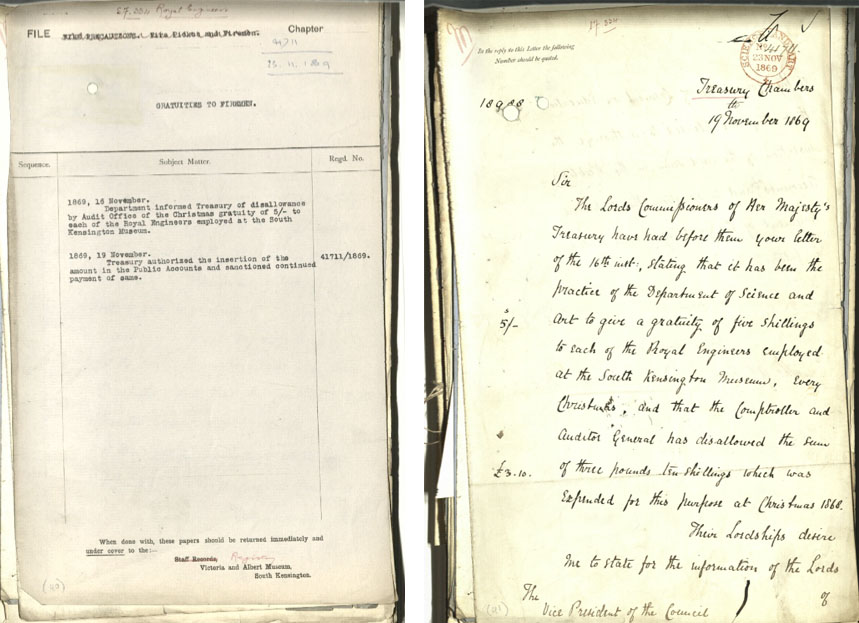
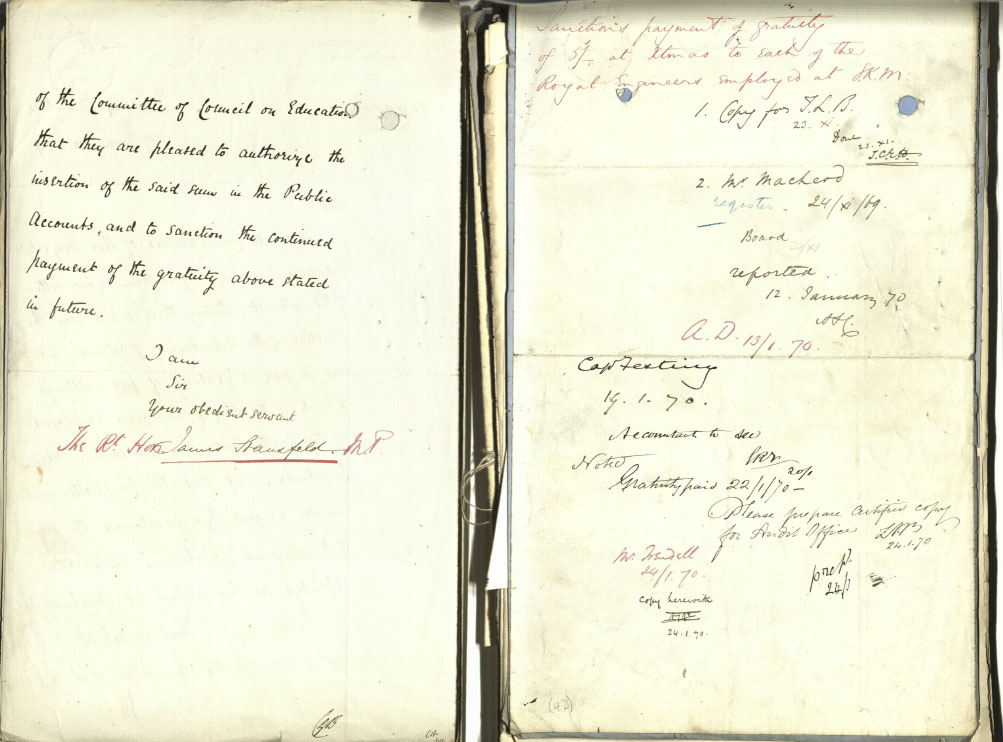
The papers for the December 1878 Christmas gratuity have not been retained, but the index confirms the usual sum was provided. Fortunately, a more detailed entry survives from 1879. On the 23 December 1879 approval was granted for the annual Christmas gratuity of 5 shillings to the ten NCOs and men of the Royal Engineers employed at the Museum. Notes to the left of the document calculate the total sum as £2 10s, paid in December 1879. The second page lists the ten members of the South Kensington detachment who received the Christmas bonus. This document (1879/6243) is stamped in green ink at the top ‘Not to be Destroyed’. Unfortunately, the documents for the succeeding Christmas bonuses were not given the same preferential treatment.
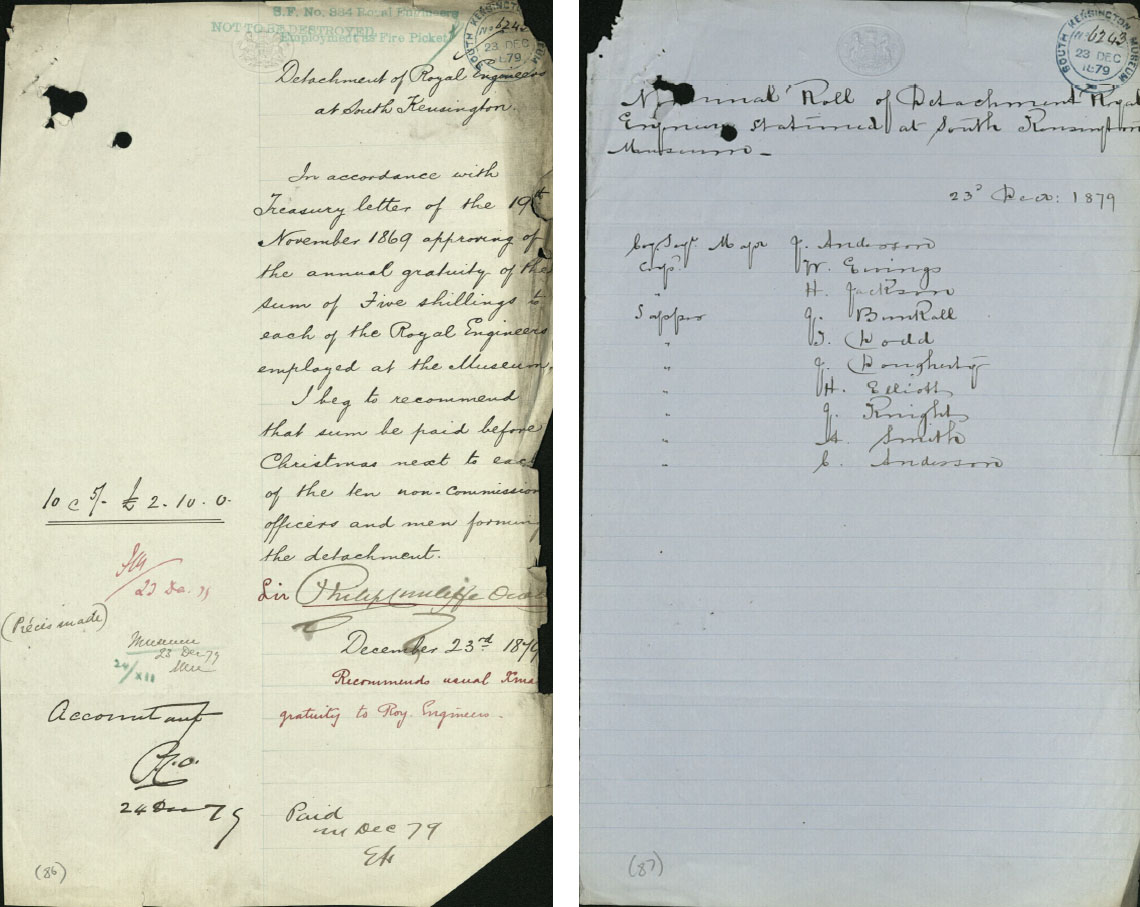
As with the records for 1878, the papers were destroyed for the December 1880 Christmas gratuity, but we know from the index that the men received the usual amount of 5 shillings each. There are no surviving Christmas gratuity records from 1881 or 1882, but we know from the index to file ED84/48 that in 1883 1 C.S.M (Company Sargent Major), 1 sergeant, 1 corporal; 1 lance corporal and 9 sappers received a bonus of 5 shillings each. Likewise, in 1886 1 C.S.M; 1 sergeant; 2 corporals; 2 lance corporals; and 7 sappers were given 5 shillings.
There are six further instances of Christmas gratuities in the index (one for each year between 1887 and 1892), but no additional information is provided, and the documents they refer to have been destroyed. There is no further mention of Christmas gratuities in ED84/48, even though the folder ends in 1901. Their destruction suggests that Christmas gratuity records were considered to be of less significance, and highlights one of the dilemmas archivists face when appraising archive material – predicting future research topics when deciding which documents to keep.
My final question was how the Christmas bonus compared with the men’s basic pay. Document 1879/1351 lists the daily and weekly pay, and explains that the men who also had museum occupations were given ‘working pay’ by the Science and Art Department in addition to their ‘regular’ (regimental) pay. Using the regular daily pay figures, I was able to calculate that the Christmas gratuity of 5 shillings was worth just under 5 days regular wages for a sapper (5s/7.5d).
| Rank | Occupation | Regular daily pay | 2017 equivalent | Regular weekly pay | 2017 equivalent |
|---|---|---|---|---|---|
| Sergeant Major | Chief of the Fire Brigade & Time Keeper | 3s/7.5d | £11.86 | £1/5s/4.5d | £83.83 |
| Corporal | Chemistry & Photography | 2s/3.5d | £7.45 | 16s/0.5d | £52.95 |
| Corporal | Clerk | 2s/3.5d | £7.45 | 16s/0.5d | £52.95 |
| 2nd Corporal | Photography | 1s/11d | £6.34 | 13s/5d | £44.40 |
| 2nd Corporal | Fire Appliances & Occasional Clerk | 1s/11d | £6.34 | 13s/5d | £44.40 |
| Sapper | Fire Appliances | 1s/1.5d | £3.59 | 7s/10.5d | £25.92 |
| Sapper | Half-time Fire Appliances; Half-time Museum | 1s/1.5d | £3.59 | 7s/10.5d | £25.92 |
| Sapper | Carpenter | 1s/1.5d | £3.59 | 7s/10.5d | £25.92 |
| Sapper | Painter | 1s/1.5d | £3.59 | 7s/10.5d | £25.92 |
| Sapper | Painter | 1s/1.5d | £3.59 | 7s/10.5d | £25.92 |
| Sapper | Painter | 1s/1.5d | £3.59 | 7s/10.5d | £25.92 |
| Sapper | Painter | 1s/1.5d | £3.59 | 7s/10.5d | £25.92 |
| Sapper | Painter | 1s/1.5d | £3.59 | 7s/10.5d | £25.92 |
| Sapper | Plumber | 1s/1.5d | £3.59 | 7s/10.5d | £25.92 |
| Sapper | Smith | 1s/1.5d | £3.59 | 7s/10.5d | £25.92 |
| Sapper | Smith | 1s/1.5d | £3.59 | 7s/10.5d | £25.92 |
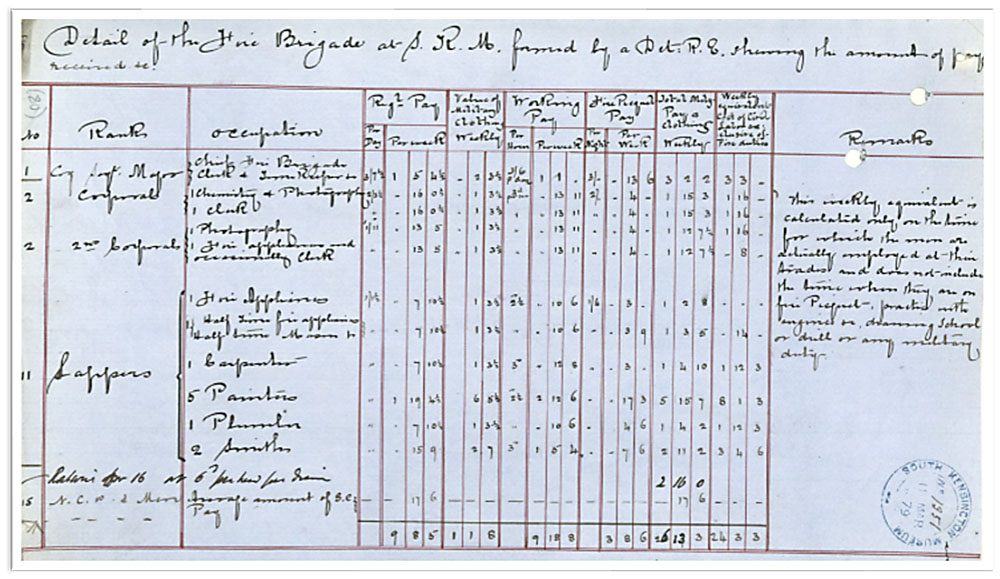
Interestingly, 1879/1351 not only tells us the pay of the soldiers, but also the number of men stationed at South Kensington Museum in March 1879 (16), their rank, and their occupation. Of note is the fact that only four of the men had occupations that involved firefighting. The variety of jobs they undertook suggests that the original purpose of their employment had evolved, and that the running of the Museum owed a lot to the men of the Royal Engineers. The sappers are perhaps a less well-known part of the history of the V&A. By bringing a small part of their story to life, I hope this blog will ensure they receive the recognition they deserve.
Thank you to my colleague Harriet for rehousing ED84/48, to facilitate the scanning of the pages that illustrate this blog.
Feeling inspired to follow your own research journey? Visit our archives to learn more about the V&A’s fascinating history.


